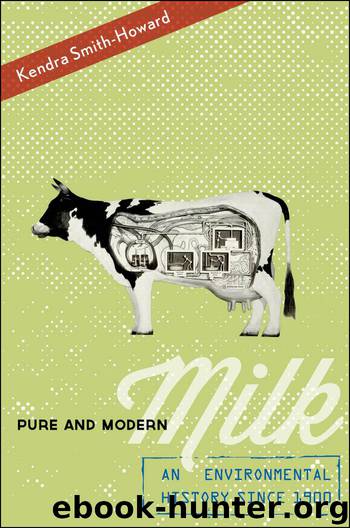Pure and Modern Milk by Smith-Howard Kendra

Author:Smith-Howard, Kendra
Language: eng
Format: epub
Publisher: Oxford University Press, USA
Published: 2014-03-14T16:00:00+00:00
Figure 5.1 The bulk tank eliminated the need to hoist heavy cans of milk but introduced new problems of milk’s purity. Consolidated Badger Cooperative Creamery Records, Wisconsin Historical Society, Green Bay Area Research Center.
By the end of the 1950s, regulations of veterinary antibiotics took a new turn, from focusing on production-related measures (like the effects of drug residues on cheese manufacture) to emphasizing the potential risks of antibiotic residues on milk consumers. By that time, a growing body of evidence suggested that low levels of antibiotics in milk—especially penicillin—heightened allergic sensitivities of those who drank it. Cheesemakers, who had once framed antibiotic-laden milk largely as a production problem, incorporated the new health concerns into their efforts to convince farm families to withhold milk from treated cows. The December 9, 1959, issue of Dairy Records advised patrons, “If anyone is inclined to brush off the F&D regulations on the use of antibiotics treating mastitis as just another silly rule of a bogyman to harass the milk producer, he is sadly misinformed. The medical profession is in agreement that some people are so allergic to penicillin and other antibiotics that even minute quantities may bring serious consequences.”16
The new findings on the potential health effects of antibiotic residues prompted the FDA to tighten restrictions on veterinary drugs. By 1957, the FDA established a maximum dosage for penicillin at 100,000 Oxford units, a significant reduction at a time when some antibiotic preparations contained as many as 1,500,000 units per dose. The agency also required antibiotic manufacturers to print warning labels directly on the container of the drug, not just in the literature accompanying the medicine, to make it more likely that the person administering the drugs would read the seventy-two-hour withholding rule.17
The FDA also stepped up testing and enforcement, especially after a simple and quick test to recognize residues in milk enabled cheesemakers and food regulators to reject contaminated milk. In 1959, the FDA launched a two-part program to sample interstate milk shipments to test for antibiotics and to train local and state milk inspectors to utilize quicker methods for residues. This program played a key role in shifting the vision of milk’s purity from one focused on bacterial impurities to one focused on technological adulterants.18
Dairy processors and food regulators both blamed the continued presence of antibiotics in milk on dairy farmers’ stubborn disregard for the seventy-two-hour withholding rule. While carelessness surely played some role, the decision of dairy farmers to disregard or uphold withholding regulations derived in part from farmers’ own perceptions of milk’s purity. Many of the farmers who erred in sending milk to market too soon after antibiotic treatment associated the visible healing of cows’ udders with the return of milk to a suitable condition to sale. These farmers defined pure milk by the absence of bacteria, not the absence of drug residues. A dairy farmer in Kansas told the local FDA inspector that “the veterinarian had told him he could use the milk as soon as the condition for which he was treating the cow cleared up.
Download
This site does not store any files on its server. We only index and link to content provided by other sites. Please contact the content providers to delete copyright contents if any and email us, we'll remove relevant links or contents immediately.
Craft Beer for the Homebrewer by Michael Agnew(18140)
Marijuana Grower's Handbook by Ed Rosenthal(3619)
Barkskins by Annie Proulx(3308)
Project Animal Farm: An Accidental Journey into the Secret World of Farming and the Truth About Our Food by Sonia Faruqi(3177)
The Plant Messiah by Carlos Magdalena(2881)
Red Famine: Stalin's War on Ukraine by Anne Applebaum(2873)
0041152001443424520 .pdf by Unknown(2784)
Organic Mushroom Farming and Mycoremediation by Tradd Cotter(2626)
In the Woods by Tana French(2532)
Beer is proof God loves us by Charles W. Bamforth(2370)
7-14 Days by Noah Waters(2361)
Reservoir 13 by Jon McGregor(2240)
Borders by unknow(2227)
Meathooked by Marta Zaraska(2220)
The Art of Making Gelato by Morgan Morano(2216)
Birds, Beasts and Relatives by Gerald Durrell(2175)
Between Two Fires by Christopher Buehlman(2163)
The 7 Habits of Highly Effective People: Powerful Lessons in Personal Change (25th Anniversary Edition) by Covey Stephen R(2139)
The Lean Farm Guide to Growing Vegetables: More In-Depth Lean Techniques for Efficient Organic Production by Ben Hartman(2096)
